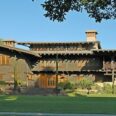
As America celebrates the 50th anniversary of the first manned spacecraft to land on the Moon, the Apollo 11 mission comes full circle to Pasadena, home of NASA’s Jet Propulsion Laboratory, and lands at the Rose Bowl, where “Apollo 11 – An Immersive 360° Adventure” premiered Friday and shows run through August.
The groundbreaking new show, with an original story performed by a full cast and presented in a spectacular lunar dome with 40,000 square feet of video projections, commemorates NASA’s most daring mission of sending astronauts to land on the Moon and get them home safely afterward.
Three Americans – Neil Armstrong, Buzz Aldrin, and Michael Collins – did just that, from July 16 to July 24, 1969, about eight years after President John F. Kennedy set that mission as a national goal in 1961.
“What we’re hoping to do is expand on that story and tell what is essentially the untold story of what it took to get that flight to the Moon,” Scott Farris, who directs the Apollo 11 show, said.
And much of that untold story actually happened inside JPL in Pasadena, where hundreds of scientists, engineers, and technicians worked for years on the research, conceptualization, engineering and development of the systems, equipment and procedures that eventually led to the success of that mission 50 years ago.
While other NASA centers were launching astronaut-piloted missions to orbit Earth and the moon at that time, JPL was working on robotic missions to support this effort, eventually developing two robotic series of spacecraft that helped pave the way for the first humans to land on the moon.
One of these lunar efforts was the Rangers series, designed to fly to the moon and intentionally collide with it, returning images of the surface and the approaching impact. Rangers 1 through 6 all failed, and Ranger 7 was the first to work properly, impacting the moon on July 31, 1964, and returning imagery much higher in resolution than possible from Earth.
These images showed Apollo planners that finding a truly smooth landing site for the astronauts would be a difficult challenge. Two more Rangers reached the moon before the program ended.
The Surveyors were “soft landers” intended to return information about the strength and composition of the lunar surface. They were the first vehicles to operate on the moon.
Built by a JPL contractor, Surveyor 1 landed successfully on June 2, 1966, demonstrating that lunar dust would not simply swallow up a spacecraft, as some had feared. It also returned images and data about the strength of the surface. Five more successful Surveyors were to follow after that.
JPL also managed construction of a space communications and tracking system, which NASA needed as the number of robotic missions grew. This system later became known as NASA’s Deep Space Network.
The Deep Space Network (DSN) started operating in 1963, and was used extensively during Apollo 11, sending home images of the first moonwalk. DSN also played a critical role in the rescue of the Apollo 13 astronauts, and returned the first-ever images of Mars.
Today, JPL continues to control the DSN from its facility in Pasadena. Set adjacent to the mission control center at the Lab, the DSN control room has been nicknamed “The Center of the Universe,” from a comment made years ago by former JPL Director Charles Elachi as he described how the control center collects information from both inside and outside the solar system.
Many of the untold stories about Apollo 11 may not be told entirely through Friday’s spectacular show at the Rose Bowl, but having it premiere in Pasadena is enough to remind viewers how important JPL’s role was in developing the science that led to a successful first lunar landing and the subsequent missions that followed.
Suffice it to say that many in the audience during the premiere Friday knew or were related to someone who worked at JPL at the time man’s most daring space mission was being planned.
“Apollo 11 – An Immersive Immersive 360° Adventure” will continue to be shown at the Rose Bowl throughout July.
For more information about show times and ticket prices, visit www.rosebowlstadium.com/
















